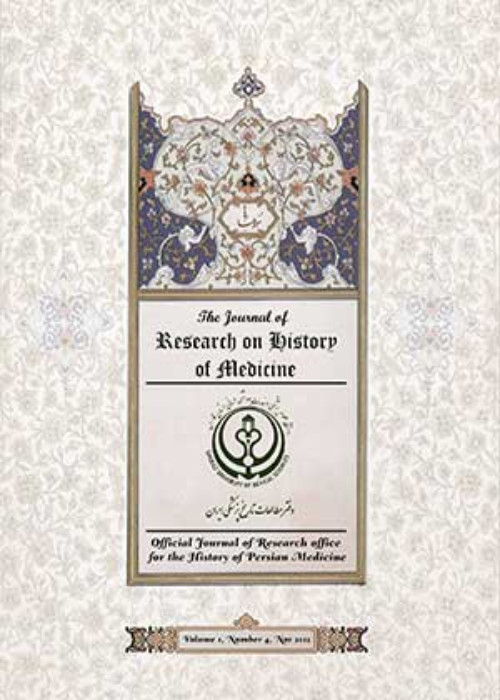فهرست مطالب
Journal of Research on History of Medicine
Volume:3 Issue: 4, Nov 2014
- تاریخ انتشار: 1393/08/30
- تعداد عناوین: 8
-
-
Page 183India is on the verge of becoming the diabetic capital of the world. The fact is that even in ancient India diabetes was prevalent and reference of diabetic-like condition is there in Atharvaveda, known as one of the oldest literature in the world. A search through ancient Indian religious, political and medical scripture shows various references of diabetes, better known aspramehaor madhumehato ancient India. Ancient Indian medicine was well developed and there are now vivid descriptions of the cause, symptoms, pathopysiology, complications and treatment of diabetes in these scriptures. Arthasastra, the famous political scripture of India even gives reference to diabetogenic techniques for destroying enemies. Charaka, Susruta and other contemporary physicians of ancient India had a scientific approach to diabetes and its management. Therefore, prevalence of diabetic has been documented in India since the Vedic period and ancient Indian scriptures have provided some valuable knowledge for diabetes.
-
Page 201When cultures collide, through its major activities that emanate from the translation, they can flourish themselves. Intimacy and familiarity of the Islamic World with Greek medical heritage which happened to be in the golden age of the Abbasids in Baghdad, led to the enrichment and prosperity of Islamic medicine. This sort of familiarity and reproductivity grew among Nestorian Christians through their attendance in the court of Caliphs, translation of Greek medical works into Syriac and Arabic and writing some medical works as well. The present study, while introducing Nestorian physicians and their medical effects and valuable services, attempted to explore and analyze historical texts, and also tried to manifest the role of Nestorian minority in the transmission of Greek medicine to Islamic civilization in the Abbasid period which led to the emergence of prominent physicians and in turn the advent of some famous works in this civilization. A glance at the history of medical life shows to what extent the role of Nestorian Christian minority in the Abbasid era is indispensable and decisive in the transmission of Greek medicine to Islamic civilization.
-
Page 221Plague is an infectious disease transmitted from rodents to humans. This disease is considered an endemic disease in western Iran. The last officially reported case of human plague in Iran was in 1965. In the last few decades, human plague has been reported in Iran’ neighboring countries. Also, according to some recent evidence witnessing infected rodents in western Iran, it is probable to have new outbreaks of the disease in the near future in Iran. Thus, it is very important for the physicians and health care personnel to know how the disease can transmit.. This study is a report of the outbreak of the disease in Gavmichan village in northern Kermanshah province in 1952, based on the available historical reports. In this outbreak, the diagnoses were confirmed by getting biopsies of parotid, auxiliary and groin glands, running bacteriology tests, smears and cultures and injecting guinea pigs. During this 20-day outbreak, 14 people were infected, of whom eight died. In 11 cases (78.57% of the patients), a close association with an infected patient was reported. Fever and swollen lymph nodes was the frequent clinical symptoms in the patients. The mean (SD) duration of the infection until death was 4.26 (0.42) days. Apparently the source of this outbreak was the wild animals in the fields around the village. It is recommended to do a comprehensive study in the western region of the country to determine the status of the plague and to monitor the disease in this region. Health care workers should be alerted to the current status of the disease in order to be able to respond appropriately to potential outbreaks.
-
Page 231Seuyoty was one of the most celebrated medieval authors in Arabic literature and during a literary period known as Mamlooki era. Although anecdote (Magama) is a literary type which is written like a story and is based on the beggarliness and trickery of the first character of the story, Seuyoty’s anecdotes (Maqaamas) are different from the anecdotes of his predecessors. Seuyoty’s Magamas are not in the form of stories. They include interesting subjects such as health, medicine, and therapy. In this article, a number of his Maqaamas are reviewed in order to show the readers some indications of medical issues in these writings.This point indicates the special attention of this renowned author to social issues and people’s affairs, including health and improving people’s knowledge of necessary social issues.
-
Page 239To physicians, meat is considered as the best nutrition because it includes rich protein that is necessary for the construction of body cells and tissues. Also meat is regarded as the basic food meeting the nutritional and therapeutic needs of human beings. Meat, because of containing the high nutritional value, has been a good indicator of economic growth and social welfare of communities. Various poets have long mentioned the vital medical benefits of meat and its therapeutic aspects. Among these poets, the renowned physician, Abdol Ghader Chakrouni Meknasi contributed greatly toward introducing the western culture and civilization to the world. This poet in his ourjouza made an attempt to classify different types of meat, their nutritional and therapeutic value. This article, through descriptive-analytical method, intents to, firstly, analyze the nature of different types of meat, their benefits and harms, and secondly, discover the medical findings of the poet over meat and compare them with the findings of modern medicine. This study has concluded that eating some meat in certain quantities may help treating certain diseases. Furthermore, grill-roasted meat is considered healthier than fried meat. This research has found that the poet’s findings about different types of meat and their therapeutic impacts and its treatment correspond to those of modern medicine in many respects.


